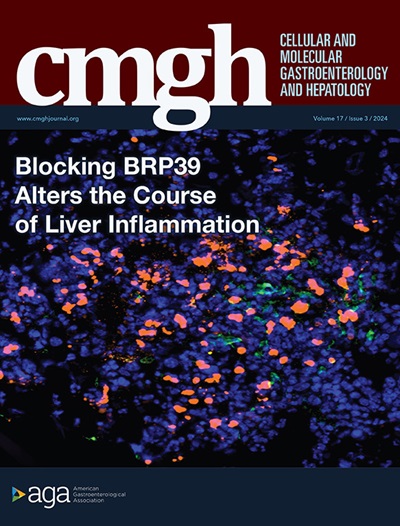Cellular Crosstalk Promotes Hepatic Progenitor Cell Proliferation and Stellate Cell Activation in 3D Co-culture
IF 7.1
1区 医学
Q1 GASTROENTEROLOGY & HEPATOLOGY
Cellular and Molecular Gastroenterology and Hepatology
Pub Date : 2025-01-01
DOI:10.1016/j.jcmgh.2025.101472
引用次数: 0
Abstract
Background & Aims
Following liver damage, ductular reaction often coincides with liver fibrosis. Proliferation of hepatic progenitor cells is observed in ductular reaction, whereas activated hepatic stellate cells (HSCs) are the main drivers of liver fibrosis. These observations may suggest a functional interaction between these 2 cell types. Here, we report on an in vitro co-culture system to examine these interactions and validate their co-expression in human liver explants.
Methods
In a 3D organoid co-culture system, we combined freshly isolated quiescent mouse HSCs and fluorescently labeled progenitor cells (undifferentiated intrahepatic cholangiocyte organoids), permitting real-time observation of cell morphology and behavior. After 7 days, cells were sorted based on the fluorescent label and analyzed for changes in gene expression.
Results
In the 3D co-culture system, the proliferation of progenitor cells is enhanced, and HSCs are activated, recapitulating the cellular events observed in the patient liver. Both effects in 3D co-culture require close contact between the 2 different cell types. HSC activation during 3D co-culture differs from quiescent (3D mono-cultured) HSCs and activated HSCs on plastic (2D mono-culture). Upregulation of a cluster of genes containing Aldh1a2, Cthrc1, and several genes related to frizzled binding/Wnt signaling were exclusively observed in 3D co-cultured HSCs. The localized co-expression of specific genes was confirmed by spatial transcriptomics in human liver explants.
Conclusion
An in vitro 3D co-culture system provides evidence for direct interactions between HSCs and progenitor cells, which are sufficient to drive responses that are similar to those seen during ductular reaction and fibrosis. This model paves the way for further research into the cellular basis of liver pathology.

细胞串联在三维共培养中促进肝祖细胞增殖和星状细胞活化。
背景:肝损伤后,导管反应常伴有肝纤维化。肝祖细胞的增殖是在导管反应中观察到的,而活化的肝星状细胞(hsc)是肝纤维化的主要驱动因素。这些观察结果可能表明这两种细胞类型之间存在功能上的相互作用。在这里,我们报告了一个体外共培养系统来检查这些相互作用并验证它们在人肝外植体中的共表达。方法:在三维类器官共培养系统中,我们将新分离的静止小鼠造血干细胞与荧光标记的祖细胞(未分化的肝内胆管细胞类器官)结合在一起,允许实时观察细胞形态和行为。7天后,根据荧光标记对细胞进行分类,分析基因表达的变化。结果:在三维共培养系统中,祖细胞增殖增强,造血干细胞被激活,重现了患者肝脏中观察到的细胞事件。在三维共培养中,这两种效果都需要两种不同细胞类型之间的密切接触。造血干细胞在3D共培养过程中的激活不同于静止的造血干细胞(3D单培养)和在塑料上激活的造血干细胞(2D单培养)。在3D共培养的造血干细胞中,只观察到含有Aldh1a2、Cthrc1和卷曲结合/ Wnt信号相关基因的一组基因上调。空间转录组学证实了特定基因在人肝外植体中的局部共表达。结论:体外3D共培养系统为造血干细胞和祖细胞之间的直接相互作用提供了证据,这种相互作用足以驱动类似于在导管反应和纤维化过程中所见的反应。该模型为进一步研究肝脏病理的细胞基础奠定了基础。
本文章由计算机程序翻译,如有差异,请以英文原文为准。
求助全文
约1分钟内获得全文
求助全文
来源期刊

Cellular and Molecular Gastroenterology and Hepatology
Medicine-Gastroenterology
CiteScore
13.00
自引率
2.80%
发文量
246
审稿时长
42 days
期刊介绍:
"Cell and Molecular Gastroenterology and Hepatology (CMGH)" is a journal dedicated to advancing the understanding of digestive biology through impactful research that spans the spectrum of normal gastrointestinal, hepatic, and pancreatic functions, as well as their pathologies. The journal's mission is to publish high-quality, hypothesis-driven studies that offer mechanistic novelty and are methodologically robust, covering a wide range of themes in gastroenterology, hepatology, and pancreatology.
CMGH reports on the latest scientific advances in cell biology, immunology, physiology, microbiology, genetics, and neurobiology related to gastrointestinal, hepatobiliary, and pancreatic health and disease. The research published in CMGH is designed to address significant questions in the field, utilizing a variety of experimental approaches, including in vitro models, patient-derived tissues or cells, and animal models. This multifaceted approach enables the journal to contribute to both fundamental discoveries and their translation into clinical applications, ultimately aiming to improve patient care and treatment outcomes in digestive health.
 求助内容:
求助内容: 应助结果提醒方式:
应助结果提醒方式:


